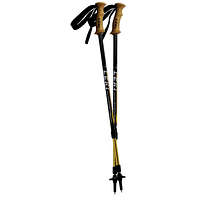Trekking Poles
Trekking Poles
I remember when I first started backpacking in 1999 and I saw people using trekking poles. They seemed alien and out of place... I mean, skiers used them, but backpackers? On dry ground? I then tried one later that summer as my knees began to hurt on a steep downhill portion of trail and a friend lent me one of hers to help... and then I saw the light. These things really help to take the pressure of your knees, especially when you're carrying the heavy weight of a backpack loaded with several days worth of food and gear. They also help you keep your balance on uneven or rocky terrain. Have you ever hiked on a trail where little loose rocks acted as ball bearings? It's very easy to fall on such a trail, but trekking poles will help you stay upright. They also help you keep upright when crossing a stream or river. Think about it... you can lift up one foot and only have one foot left on the ground to keep your balance as ice cold water is moving swiftly around you... or you can lift one foot while having one other foot plus two trekking poles helping to keep your balance. This is a much smarter and safer way to cross a river!Other benefits of poles: Your upper body gets a little bit of a workout where normally your lower body is doing most if not all of the work. They help you keep a steady rhythm of hiking. You can use your arms to help you climb a steep trail. They help keep your hands from becoming swollen while you're hiking. Many tarp tents can be set up with trekking poles. You can use your pole to push back vegetation, like poison oak, that you don't want to touch. They can even deter or help defend yourself against a wild animal.
Some people like using one, some people like using two. Most trekking poles these days are made of a high-strength aluminum. They are adjustible for height. Some break down into smaller sections than others. Some use twist-locks for adjusting the sections, some use flick-locks. They have plastic, rubber, or cork hand grips. They have hard tips usually made out of tungsten or carbide and some have removable rubber tips (makes for quieter walking on pavement and less impact on sensitive areas). Some have removable snow baskets so your trekking poles can become snowshoe poles. Some trekking poles are anti-shock which means they have some means for absorbing the downward force of the pole against the ground. Some have an avalanche probe built in. Some have a camera mount built in (so you can turn your trekking pole into a monopod).
You can buy a cheap pair of trekking poles at places like Wal-Mart or Big 5 Sporting Goods (around $20/pair) and some people swear that these do the job just fine... or you can opt for more famous brands with more features (up to $150-200/pair). I myself have used a pair of Komperdell Poles for 5 years now that I bought on sale at Sierra Trading Post for $59 and have been quite happy with them.






